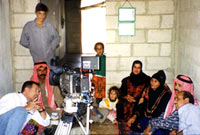Jordan - The Badia Program

The Badia is a largely undeveloped track of land roughly the size of North Dakota. The Badia makes up 80 percent of Jordan and reaches into Syria, Iraq and Saudi Arabia. The black basalt plains cover much of the Northern Badia. These stones make it hard to drive or to walk, for humans and animals alike. Camels, able to travel long distances without water, were for centuries the only reliable transportation in the Badia.
To survive here a plant needs deep root and stamina. With an average annual rainfall of only 2 to 8 inches, seeds can lie dormant for months, even years, waiting for rain. When it comes - usually in the spring, there is an explosion of bloom and new growth.
Today, herdsmen drive trucks, and camels are greatly outnumbered by sheep and goats, which threaten to overgraze this spartan land. Jordan has 2.5 million sheep - three times as many as the land would comfortably support.

Scientists with the Badia Program, most with masters or doctorate degrees from the USA or England actively work with local families to improve their agricultural income, often by growing new crops, such as medicinal plants

Badia Program supports education
Contact the webmaster to report any problems with this site.
New Mexico State University is an equal opportunity/affirmative action employer and educator. NMSU and the U.S. Department of Agriculture cooperating.